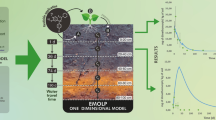Abstract
The model employed for simulating the fate of pesticides in soil was based on the one dimensional convective-dispersive-reaction equation. The model assumed a constant pore-water velocity (v), linear equilibrium adsorption, and first-order degradation. The adsorption parameter (kd) was calculated from molecular structure with the help of a first-order molecular connectivity index. On the basis of the results of sensitivity analysis the model was made partially stochastic in order to account for horizontal heterogenity in a field soil. Concentration profiles were obtained by employing the mode, median and mean values of (v, D) while the values of kd and t1/2 were kept constants; where D and t1/2 were the apparent diffusion coefficient and the degradation half-life, respectively. The resulted extremes in concentration profiles were expected to be observed within a relatively small area of the heterogeneous filed soil. A random variable, namely the contaminated depth, ζ was defined so that the soil beneath it would be practically free of pesticide during its entire life-time. The values of (ξ1, ξ2, ξ3) under continuous leaching were (0.14, 0.56, 1.00 m), (0.29, 1.50, 2.62 m), and (0.65, 2.25, 4.00m) for DDT, toxaphene and lindane, respectively; where ξ1, ξ2 and ξ3 were values of ζ calculated by employing the mode, median, and mean values of (v, D), respectively. Within a relatively small area the first value would be frequently observed whereas the others would be less pronounced. The depth and shape of the resultant base of the contaminated zone were substantially more sensitive to changes in the surface rates of recharge than to changes in the values of the chemical parameters kd and t1/2. The implication of the results for the assesment of pesticide contamination of groundwaters were discussed.
Similar content being viewed by others
References
Abdel-Gawad A A 1985 Pesticide residues levels in soils and crops. 1. Pesticide residues in Kalubia and Monofia governorates. 2nd Inter. Cong. Soil Pollution. Zagazig University. Egypt. Part II, 87–108.
Briggs G 1981 Theoretical and experimental relationships between soil adsorption, octanol-water partition coefficients, water solubilities, bioconcentration factors, and the parachor. J. Agric. Food Chem. 29, 1050–1059.
Cohen S Z, Creeger S M, Cassel R F and Enfield C G 1984 Potential pesticide concentration of groundwater from agricultural uses.In Treatment and Disposal of Pesticide Wastes. Eds. R Krueger and J N Seiber. pp 294–325. ACS Symp. Ser. 259. Am. Chem. Soc., Washington, DC.
Dagan G and Bresler E 1979a Solute dispersion in unsaturated heterogeneous soil at field scale. I. Theory. Soil Sci., Soc. Am. J. 43, 461–467.
Dagan G and Bresler E 1979b Solute dispersion in unsaturated heterogeneous soil at field scale. II. Applications. Soil Sci. Soc. Am. J. 43, 467–472.
Elprince A M Ed. 1986 The Chemistry of Soil Solutions: Benchmark Papers in soil science. Van Nostrand Reinhold Company, Stroudsburg, PA, USA, 411 p.
El-Sebae A H and Soliman S A 1982 Mutagenic and carcinogenic chemicals in the Egyptian agricultural environment.In Genetic Toxicology. Eds. R A Fleck and A Hollaender. pp 177–187. Plenum Publishing Corporation, NY.
Hamaker J W 1972 Decomposition: quantitative aspects.In Organic Chemicals in the Soil Environment. Eds. C A I Goring and J W Hamaker. pp 253–340, Marcel Dekker, Inc., NY.
Hamaker J W and Thompson J M 1972 Adsorption.In Organic Chemicals in the Soil Environment. Eds. C A I Goring and J W Hamaker. pp 49–144. Marcel Dekker, Inc., NY.
Hiltbold A E 1974 Persistence of pesticide in soil.,In Pesticides in Soil and Water Ed. W D Guenzi. pp 203–220. Soil Sci. Soc. Am., Inc. Publisher, Maidson, WI, USA.
Jury W A, Spencer W F and Farmer W J 1983 Behavior assessment model for trace organics in soil I. Model description. J. Environm. Qual. 12, 558–564.
Jury W A, Spencer W F and Farmer W J 1984 Behaviour assessment model for trace organics in soil: Application of screening model. J. Environ. Qual. 13, 573–579.
McCuen R H and Snyder W M 1986 Hydrologic Modeling. Prentice-Hall, NJ 403 p.
Nash R G 1980 Dissipation rate of pesticides from soils.In Cream. vol. 3. Ed. W G Knisel. pp 560–594. U.S. Department of Agriculture. Washington, DC.
Pionke H B, Glotfelty D E, Lucus A B and Urban J B 1988 Pescitide contamination of groundwaters in the Mahantango creek watershed. J. Environ. Qual. 17, 76–84.
Rao P C and Davidson J M 1980 Estimation of pesticide retention and transformation parameters required in non point source pollution models.In Environmental Impact of Nonpoint Source Pollution. Eds. M R Overcash and J H Davidson. pp 23–67. Ann Arbor Science Publisher, Inc., Ann Arbor, MI, USA.
Sabljic A 1984 Prediction of the nature and strength of soil sorption of organic pollutants by molecular topology. J. Agric. Food Chem. 32, 243–246.
Sheta T H 1981 Sodium-calcium exchange in Nile delta soils. Soil Sci. Soc. Am. J. 45, 749–753.
Suarez D L and van Genuchten M Th 1981 Leaching and water-type effects on ground-water quality. Journal of the Irrigation and Drainage Division, ASCE, 107, 35–52.
Travis C C and Etnier T L 1981 A survey of sorption relationships for reactive solutes in soil. J. Environ. Qual. 10, 8–17.
Van Genuchten M Th 1981 Analytical solutions for chemical transport with simultaneous adsorption, zero-order production and first-order decay. J. Hydrology 49, 213–233.
Wagenet R J and Addiscott T M 1987 Estimating the variability of unsaturated soil hydraulic conductivity using simple equations. Soil Sci. Soc. Am. J. 51, 42–47.
Author information
Authors and Affiliations
Rights and permissions
About this article
Cite this article
Shaaban, Z., Elprince, A.M. A simulation model for the fate of pesticide residues in a field soil. Plant Soil 114, 187–195 (1989). https://doi.org/10.1007/BF02220797
Received:
Revised:
Issue Date:
DOI: https://doi.org/10.1007/BF02220797




